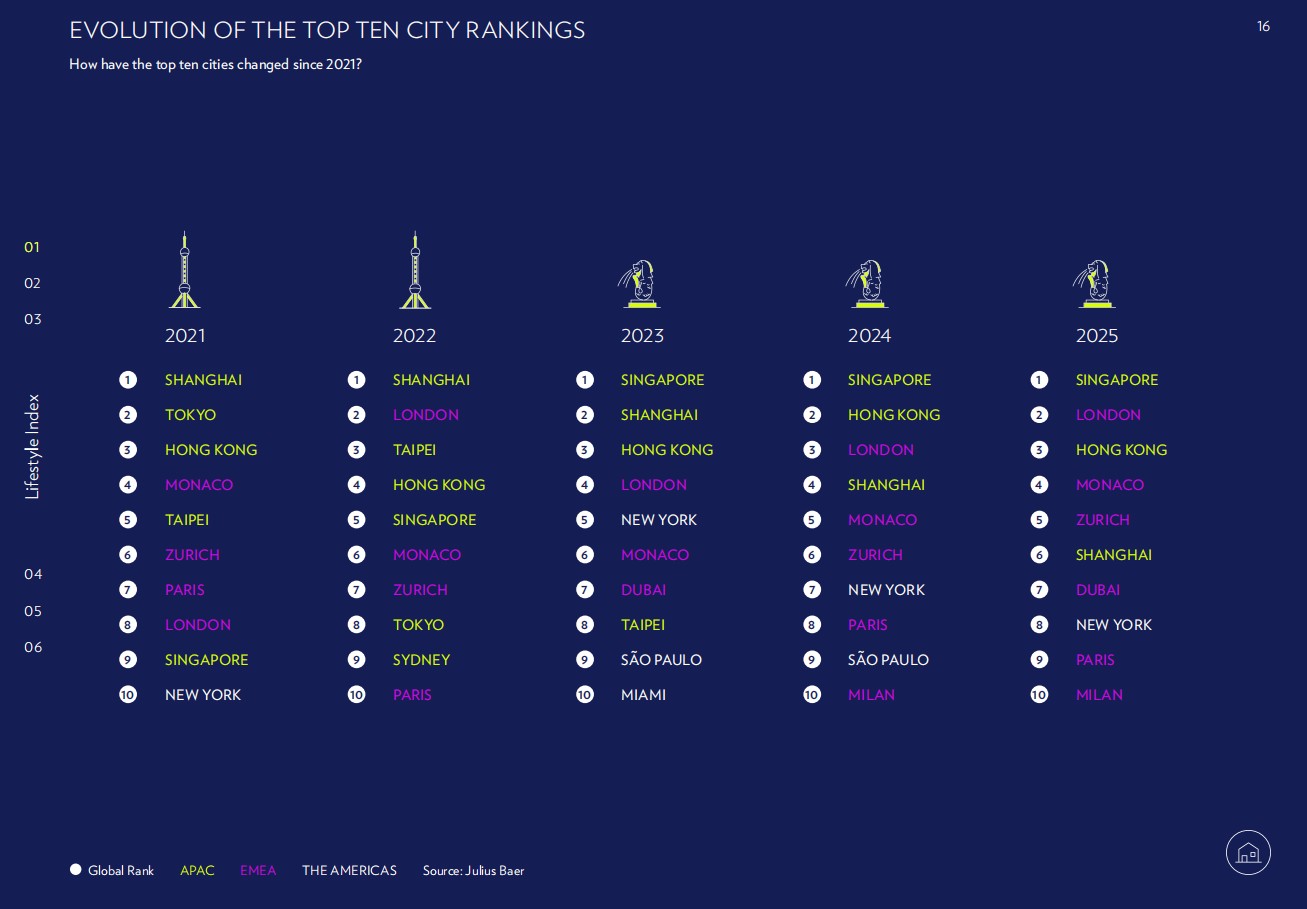For the third consecutive year, Singapore has ranked as the world’s most expensive city for high-net-worth individuals (HNWIs) to live well, according to the Julius Baer Global Wealth and Lifestyle Report 2025, released on 10 July 2025.
The report, compiled by Swiss private bank Julius Baer, assesses the cost of a premium lifestyle in 25 global cities, based on a basket of 20 goods and services commonly purchased by HNWIs.
Despite the high costs, Singapore continues to be regarded as one of the most liveable cities globally.
The report credits its political stability, personal safety, efficient governance, and superior services in education and healthcare as major draws for wealthy individuals and businesses alike.
“With the current unpredictable nature of the world, Singapore is valued for its stability, security and connection to Asia and beyond,” the report noted.

Asia-Pacific dominates the rankings
The Asia-Pacific region featured prominently in the 2025 rankings.
Alongside Singapore in first place, Hong Kong placed third and Shanghai sixth, maintaining the region’s strong showing.
The region also posted the smallest average price decline of 1 per cent in US dollar terms, marking it as the most stable among those surveyed.
This resilience is attributed partly to steady economic fundamentals and evolving consumer demands.
Chua Jen-Ai, Asia research analyst at Julius Baer, commented: “Firm fundamentals have set the stage for the rapid ascent of wealth in the region,” even as the region faces disproportionate impacts from global tariff tensions.
Lifestyle costs diverge by region
Asia-Pacific recorded some of the sharpest increases in lifestyle-related expenditures.
HNWIs in the region experienced the highest spending surges in high-end women’s fashion, luxury hotels, and fine dining.
Eighty per cent of Asia-Pacific HNWIs reported increased assets over the past year.
This sustained wealth expansion is driving demand for premium services and luxury experiences.
Singapore led globally in the cost of cars and women’s handbags.
It also ranked second for women’s shoes and third for residential property and healthcare.
Soaring air fares mark a global trend
Business class air fares surged across all regions, with the Asia-Pacific region seeing an average increase of 12.6 per cent.
The global average increase was even higher at 18.2 per cent.
This growth is attributed to supply constraints, increased demand for leisure travel, and changing business travel patterns post-pandemic.
Airlines have shifted strategies, offering more premium seats and fewer first-class options, effectively pushing business-class prices upward.
Health and longevity remain top priorities
The report found that 100 per cent of surveyed HNWIs in Asia-Pacific are actively taking measures to increase their lifespan.
This includes investing in healthcare, lifestyle changes, and in some cases, more experimental longevity interventions.
This strong interest in health and wellness is more prominent in the Asia-Pacific region than in Europe and the Americas, where HNWIs are increasingly favouring experiential spending and human interaction.
Shifting global consumption patterns
Notably, the Julius Baer Lifestyle Index declined by 2 per cent in US dollar terms for the first time since the report’s inception.
This is a significant reversal, as high-end consumer prices have typically risen at twice the rate of general consumer prices.
The drop was led by a 3.4 per cent fall in the price of goods, while services declined marginally by 0.2 per cent.
Technology packages and luxury accessories saw the largest declines in price.
Julius Baer’s head of research, Christian Gattiker, described the findings as “a surprising development in a segment that has traditionally outpaced average consumer price growth”.
He added that the index provides a snapshot from before the latest round of tariffs introduced by the US, indicating that further volatility is expected.
“In light of ongoing uncertainty, trade tensions, and tariffs, our findings represent the final moment ‘before’ the current situation,” Gattiker said.
“Next year’s Global Wealth and Lifestyle Report will likely provide a fascinating ‘after’ perspective.”
Regional dynamics and outlook
While Singapore continues to thrive as a global wealth destination, other Asia-Pacific cities are also rising.
Bangkok climbed six positions to 11th, while Tokyo reached 17th.
However, Shanghai’s drop from fourth to sixth signals shifting dynamics within the region.
Singapore’s dominance, however, is expected to persist, bolstered by its regulatory environment, urban infrastructure, and appeal to global talent.
Earlier, the Henley Private Wealth Migration Report 2025, released on 24 June, noted that Singapore is projected to attract 1,600 millionaires in 2025.
This marks a decline from the estimated 3,500 HNWIs who migrated to the city-state in 2024.
Despite the drop, Singapore remains one of the world’s leading destinations for relocating millionaires, ranking sixth globally.
The post Singapore retains top spot as most expensive city for the wealthy in 2025 Julius Baer report appeared first on The Online Citizen.


